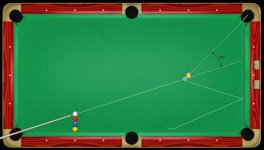Even Stan has admitted to the fact that a player must ensure, once they are in full stance, that their cue is in fact aligned to ccb. He said something like any final fine adjustment to ccb is no different than the adjustment one would normally use on any straight in shot. I can probably find that video, but I don't want to.
I'm just pointing out that when we address the cb we do whatever we have to do to ensure everything looks and feels right. We can call this fine tuning, adjusting, doublechecking, or whatever, but in the end it all comes down to one thing: Does it feel good. Do I feel like I am dead on line here, or does something feel wrong because it looks wrong? Usually, we pull the trigger anyway. If it looks wrong, it's because somewhere deep in your head your brain is sending a message, a "feeling" that something is off, because what you're seeing is either in conflict with or not registering with any knowledge you already have in storage. Either way, it calls for a restart. Stand up and look at the shot again, maybe pull another aiming tool out of the bag, like actually looking at the contact point.
